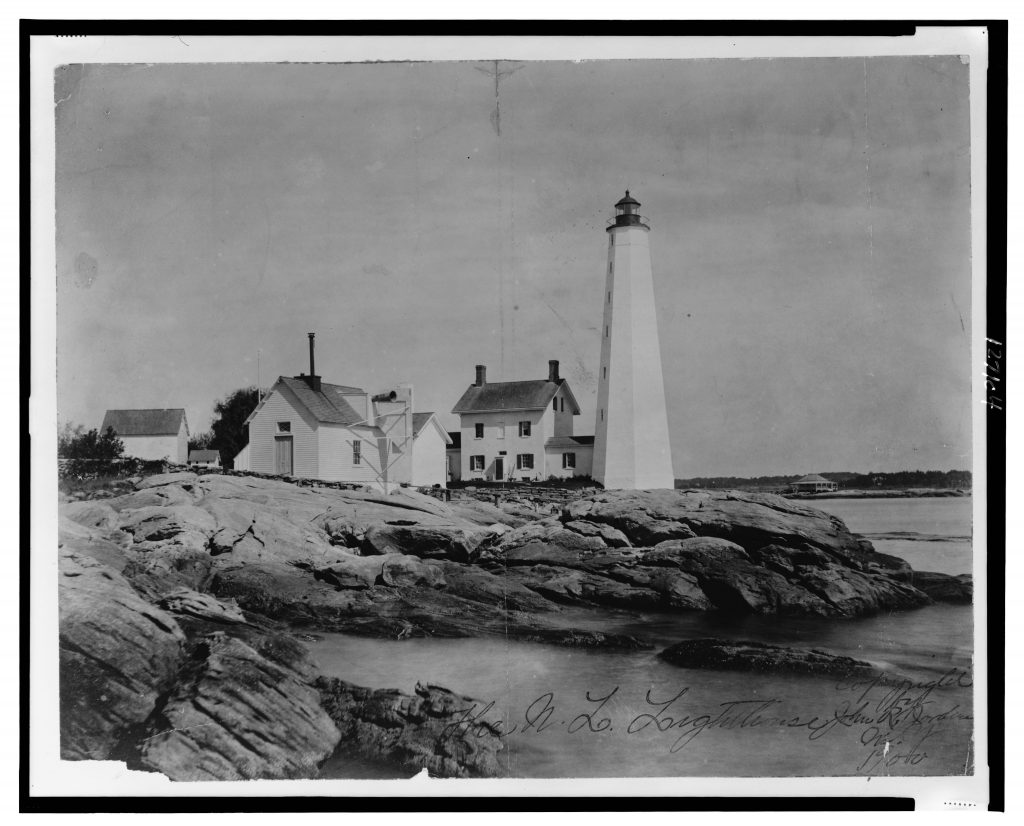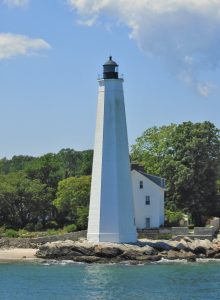By Edward T. Howe
New London Harbor Lighthouse, originally opened in 1761 and rebuilt in 1801, is Connecticut’s oldest surviving and tallest lighthouse. It is located on the west side of the entrance to New London harbor. Although currently owned by the New London Maritime Society, the US Coast Guard operates the lighthouse with a light that can be seen for 15 miles.
Establishment of a Lighthouse
New London harbor, at the mouth of the Thames River in southeastern Connecticut, provides easy access to Long Island Sound and the Atlantic Ocean thanks to its large, safe, and deep port. During the 17th and early 18th centuries, New London merchants expanded their intercoastal and West Indies trading relationships but without a lighthouse, nearby vessels sometimes ran aground and lost their cargo. In the 1730s, New London constructed a beacon (bonfire) to warn residents of the approach of enemy ships but it did not assist trading vessels with navigation.
In 1759, Nathaniel Shaw sold some of his land to New London for construction of the much-needed lighthouse. A year later, the colonial government authorized the sale of lottery tickets to fund the construction of the first official lighthouse built on Long Island Sound. The lighthouse—a 64-foot stone tower with a wooden lantern on top fueled by whale oil—officially began operations on November 7, 1761, with Shaw acting as the first lighthouse keeper.
The lighthouse both provided a fixed point of reference to safely guide marine craft into the harbor and acted as part of a coastal defense network. It became the fourth lighthouse with illumination in the colonies after Boston Light (1716), Brant Point Light on Nantucket Island (1746), and Beavertail Lighthouse at Jamestown, Rhode Island (1749). To finance its operation and maintenance, the colonial government collected taxes on coastal shipping.
On August 7, 1789, with the Lighthouse Act, Congress authorized the transfer of all existing lighthouses (and the assumption of all expenses for their support, maintenance, and repairs) to the federal government. Subsequently, in May 1790, control of the New London Harbor Lighthouse passed to the Collector of Customs under the US Treasury.
The Need for a New Lighthouse
By 1799, the original lighthouse had developed a ten-foot crack and was too short to be seen from certain directions—rendering its services ineffective. To solve this problem, Congress funded a new structure—the current structure—that opened in 1801 with an octagonal, tapered tower of thick brick walls resting on a foundation of mixed stones—89 feet above the water. Oil lamps produced light with an eclipser that flashed at three-second intervals.
Over the next several decades, the lighthouse received extensive repairs that included a new stone deck, whitewashing and repointing of the exterior to prevent the entry of water, a copper dome and weathervane, a new wooden staircase, and a new outer door. These refurbishments helped ensure commercial growth as New London became one of the largest whaling ports in the world during the 19th century. In 1857, the lighthouse received a major upgrade with the installation of a fourth order Fresnel lens that projected more intense light over a wider area. Installed in 1874, a second class fog signal and a Daboll trumpet—invented by a local New Londoner, Celadon Leeds Daboll—provided an additional level of protection and warning. Although upgraded over the years, the fog signal moved to the New London Ledge Lighthouse in 1911 after residents complained of the persistent noise.
In 1912, the lighthouse became automated with acetylene as the new light source until it was eventually converted to electricity. The US Coast Guard gained control of the lighthouse in 1939 after its merger with the previous owner, the US Lighthouse Service. In 2009, the New London Maritime Society took ownership of the lighthouse, but the coast guard continues to oversee its operation.
Edward T. Howe, Ph.D., is Professor of Economics, Emeritus, at Siena College near Albany, N.Y.









